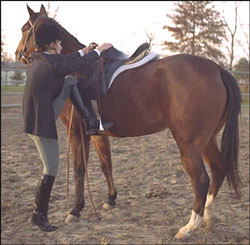
The Mounting method affects saddle pressure
Back problems are often blamed for poor performance and behavioural problems in horses. An ill-fitting or damaged saddle can cause pain. But does the way the rider mounts affect the horse's back?
The Equine Performance Center, at Michigan State University’s College of Veterinary Medicine, at East Lansing, have been investigating the forces that the saddle exerts on a horse’s back.
Their study looked at how the pressure under the saddle differed depending on whether the horse was mounted from the ground or from a raised mounting block.
Ten experienced riders, of different weights and heights, took part in the study. Each mounted the horse from the ground and from a mounting platform. The horse, a 14 yr riding horse gelding, was clinically sound, had no back problems, and was ridden in a correctly fitting dressage saddle.
A pad placed under the saddle contained an array of pressure sensors. Each individual measurement was analysed to produce an overall picture of the pressure gradients.
The study showed that the horse’s withers play an important part in stabilising the saddle as the rider mounts. There was a marked downward force in the left stirrup as the riders right leg swung upwards. The total force was significantly higher in horses mounted from the ground, than in horses mounted using a platform. If the area under the saddle was divided into quadrants (inner and outer, front and back) on each side, the peak pressure occurred at the right fore inner (by the withers) and left fore outer quadrants.
Unsurprisingly, the study also confirmed that heavier riders exerted greater pressures on the horse's back. From their results, the scientists calculated that a rider weighing 50kg mounting from the ground would exert a maximum total force of 547N. A 100kg rider would exert a maximum total force of 914N (N=Newton).
However, it is not so much the maximum total force that caused problems. The forces recorded during mounting were actually slightly lower than those recorded when the horse was ridden at a walk, and much lower than during cantering.
Similarly the inertial effect caused by the right leg swinging up was less than that measured during the trot and canter. These pressures were distributed evenly and were only likely to present a problem if the saddle did not fit properly.
More important is the fact that the forces experienced during mounting are asymmetrical – concentrating the pressures on localised areas at the right withers.
The scientists suggest that heavier riders should be encouraged to use a mounting block rather than mount from the ground, regardless of how agile or tall they are. This should help limit the possible harmful effects of mounting from the ground.
Wide, flat withers make it more likely that the saddle will slip towards the side of mounting. This is especially so when the saddle tree is narrow and sits too high above the withers.
